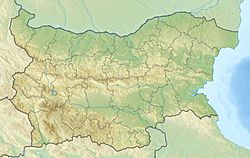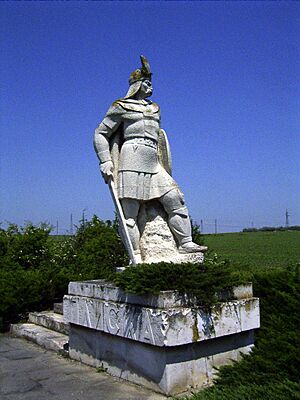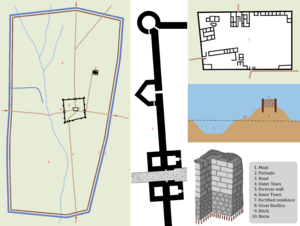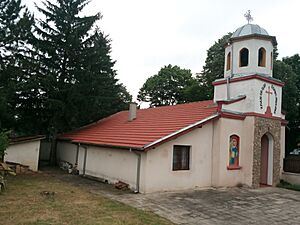Pliska facts for kids
Quick facts for kids
Pliska
Плиска
|
|
|---|---|
|
Town
|
|
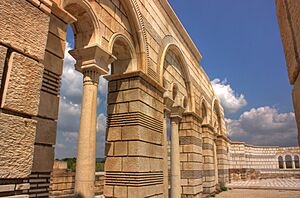
The Great Basilica in Pliska
|
|
| Country | Bulgaria |
| Province | Shumen |
| Municipality | Kaspichan |
| Area | |
| • Total | 34.356 km2 (13.265 sq mi) |
| Elevation | 145 m (476 ft) |
| Population | |
| • Total | 1,016 |
| • Density | 29.573/km2 (76.59/sq mi) |
Pliska (Bulgarian: Плиска) was the very first capital city of the First Bulgarian Empire. This empire existed during the Middle Ages. Today, Pliska is a small town in Shumen Province, Bulgaria. It sits on the Ludogorie plateau, about 20 kilometers (12 miles) northeast of Shumen.
Pliska became the capital of Bulgaria around the late 7th century. Legend says it was founded by Asparuh of Bulgaria. However, archaeologists have not found proof of this. The site might have started as a camp. There is no clear evidence of a settlement before the 9th century.
By the early 9th century, Pliska was a strong city. It had a large defensive wall around it. An outer earth wall, 21 kilometers (13 miles) long, also protected the city. In 811, the Byzantine army attacked and burned Pliska. The Byzantine emperor Nikephoros I led this attack.
After the attack, Omurtag rebuilt Pliska. He used stones from old Roman buildings. His new palace had a design similar to Roman buildings. When Boris I became Christian in 864, Pliska's religious buildings changed. The famous Great Basilica was built then. A monastery was also added. This monastery was home to the students of Saints Cyril and Methodius.
Later, Tsar Simeon I moved the capital to Preslav. Pliska slowly became less important. Around the year 1000, Byzantine generals captured Pliska. This happened during the wars of Emperor Basil the Bulgar-Slayer. These wars ended the First Bulgarian Empire.
Contents
History of Pliska: Bulgaria's First Capital
Before the Bulgarian State (Pre-681 AD)
In 680 CE, a group called the Bulgars crossed the Danube River. They moved into lands that are now part of Bulgaria. This area was mostly home to Slavic farmers. The Bulgar army was led by Asparuh. He was one of the sons of Kubrat, a powerful Bulgar chief.
Asparuh and his warriors entered the lands south of the Danube. The Byzantine Emperor Constantine IV was not happy. He led an army to stop the Bulgars. But the Byzantine army lost badly in the Battle of Ongal. After this defeat, Asparuh made the local Slavic tribes pay him tribute.
In 681, the Byzantine Empire had to sign a treaty. This treaty officially recognized the new Bulgar state. Before this, Byzantium pretended the area was still theirs. This was the first time the Byzantine Empire accepted another state in the Balkans.
Pliska as the Capital (681-893 AD)
Pliska served as the capital of the First Bulgarian Empire from 681 to 893 AD. A Bulgarian story says that Khan Asparukh founded it. At its largest, Pliska covered about 21.8 square kilometers (8.4 square miles). It was surrounded by large earthen walls. Inside these walls, a smaller stone fort was built. This fort held the palace and homes for important people.
Pliska grew for almost a century as the capital. But it was not a peaceful time. The Bulgars and the Byzantine Empire were often at war. Emperor Constantine V fought nine campaigns against the Bulgars. This was between 741 and 775.
In 811, Emperor Nikephoros I attacked Pliska. He led a huge army to get revenge. The Bulgarians had captured a city called Sardika earlier. The Bulgarian leader Krum was not ready for such a big army. So, he left Pliska. The Byzantines then robbed the palace and town. They burned it all down because most buildings were made of wood. Soon after, Khan Krum drove out the invaders in the Battle of Pliska.
Later in the 9th century, during the rule of Boris I, Pliska changed. The old pagan temples likely became Christian churches. In 886, Boris I started the Pliska Literary School. This school later moved to Preslav.
When Boris became sick, his son Vladimir took over. Vladimir tried to bring back the old pagan religion. During his rule (889–893), the large stone basilica in Pliska was badly damaged. Boris then left his monastery to remove his son from power. After succeeding, he moved the capital to Preslav. Preslav was a center for Christianity. Pliska then slowly lost its importance.
The First Bulgarian state ended when the Byzantine general John I Tzimiskes conquered Bulgaria. He defeated the Kyivan Rus' forces that had taken over Bulgaria. Pliska was destroyed between 969 and 972 during this war. It was never rebuilt.
Exploring the Ruins of Pliska
The Bulgars built an earthen wall soon after settling in Pliska. This area inside the wall is called the Outer Town. It had many small cottages. There was also space for animals like livestock and horses. This layout was unusual. It might be because the Bulgars were nomads before building Pliska. When they worked with the local Slavs, they developed a mixed economy. They raised animals and farmed.
The Inner Town was likely built later. It had a palace, a basilica, and buildings for important people. This area was inside a stone fort. The Inner Town was surrounded by the Outer Town. The Outer Town was then surrounded by the large earthen wall.
We know much less about Pliska before it became Christian. No stone buildings are definitely from before 864/5 AD. Many wooden buildings, thought to be from the pagan era, were built later. It's not clear which buildings were built right after 681. When the earthen wall was built, Pliska had very few people. Maps suggest there were only a few small settlements then. By the 10th century, there might have been thirty.
It is still a mystery why the earthen wall around Pliska was so big. Some areas were likely for people who worked for the palace. Farming also happened inside the earthen wall. There was a lot of open land inside the wall. Experts believe Pliska was first built for military reasons. It did not become a typical city with lots of trade and people until after 864/5 AD.
Most stone buildings in Pliska were built between this time and the Byzantine conquest in 971. These buildings show a clear Byzantine influence. For example, a 4-kilometer (2.5-mile) canal brought water to the Inner Town. This canal fed a large brick tank. This tank had rooms with private baths.
Only some parts of the ancient city have been fully explored. One well-studied area is Asar-dere. This area is west of the stone fort. Four clay furnaces were found here. This suggests that Pliska had skilled pottery makers. It also shows an urban economy at some point.
At first, these finds suggested that early Pliska was mostly about farming and animals. Later, it developed advanced crafts. This was supported by the late date of the first glazed pottery found. These were from the late 9th century or later.
However, newer studies of Asar-dere show something different. This area had a large waste site, hearths, and kilns from the very first period. The waste shows that ceramics were made early on. Other finds from this first period (8th to early 9th century) include iron processing materials. Glass fragments also suggest glassmaking from this time. These types of finds are not common in the 10th and 11th centuries. At that time, the area had many small, simple pit-houses.
One expert, Henning, suggests that a highly skilled craft production came first. Then, the area became more rural later on.
Discussions Among Experts
Some experts, like Georgiev and Kirilov, have different ideas. They suggest Pliska might not have been the capital all the time. Georgiev thinks Pliska was only a seasonal home with small wooden buildings. This would be true until at least the mid-8th century. Kirilov suggests that Bulgar rulers moved around. They might have traveled between different homes, like some medieval kings.
Also, before some recent finds, it was thought that Pliska did not become a true large town until the late 9th or early 10th century. However, new discoveries might change this idea. Ceramic pieces found in pit-houses suggested they were from a later period. But one pit-house, "grubenhaus No. 8," changed this view. Many researchers now think the pit-houses might have been built much earlier. This means the famous Great Basilica might have been built later than thought, perhaps as late as the 10th century.
Pliska Today
The old city of Pliska is now in ruins. These ruins are about 3 kilometers (1.8 miles) north of the modern village of Pliska. The site is a National Archaeological Reserve. You can see the ruins of the Great and Small Palaces there. You can also see the strong stone walls. The Great Basilica (built around 875) is also there. It was used as a royal church and a national church.
During Ottoman rule, the modern village was called Aboba. It kept this name until 1925. Then it was changed to Pliskov, and later to Pliska in 1947. The village has about 1,124 people. It is located 146 meters (479 feet) above sea level. This is in Shumen Province, at the south end of the Ludogorie plateau. It is about 400 kilometers (250 miles) northeast of Sofia.
Images for kids
-
Monument to Boris I


